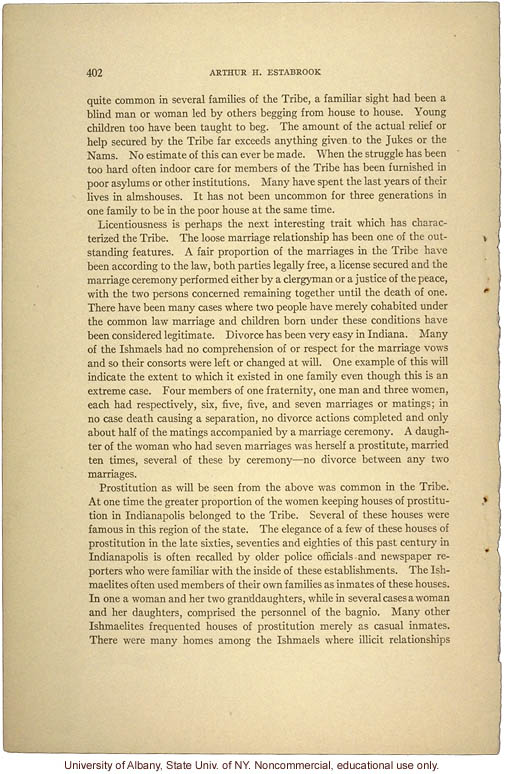402 Arthur H. Estabrook
quite common in several families of the Tribe, a familiar sight had been a blind man or woman led by others begging from house to house. Young children too have been taught to beg. The amount of the actual relief or help secured by the Tribe far exceeds anything given to the Jukes or the Nams. No estimate of this can ever be made. When the struggle has been too hard often indoor care for members of the Tribe has been furnished in poor asylums or other institutions. Many have spent the last years of their lives in almshouses. It has not been uncommon for three generations in one family to be in the poor house at the same time. Licentiousness is perhaps the next interesting trait which has characterized the Tribe. The loose marriage relationship has been one of the outstanding features. A fair proportion of the marriages in the Tribe have been according to the law, both parties legally free, a license secured and the marriage ceremony performed either by a clergyman or a justice of the peace, with the two persons concerned remaining together until the death of one. There have been many cases where two people have merely cohabited under the common law marriage and children born under these conditions have been considered legitimate. Divorce has been very easy in Indiana. Many of the Ishmaels had no comprehension of or respect for the marriage vows and so their consorts were left or changed at will. One example of this will indicate the extent to which it existed in one family even though this is an extreme case. Four members of one fraternity, one man and three women, each had respectively, six, five, five, and seven marriages or matings; in no case death causing a separation, no divorce actions completed and only about half the matings accompanied by a marriage ceremony. A daughter of the woman who had seven marriages was herself a prostitute, married ten times, several of these by ceremony -- no divorce between any two marriages.
Prostitution as will be seen from the above was common in the Tribe. At one time the greater proportion of the women keeping houses of prostitution in Indianapolis belonged to the Tribe. Several of these houses were famous in this region of the state. The elegance of a few of these houses of prostitution in the late sixties, seventies and eighties of this past century in Indianapolis is often recalled by older police officials and newspaper reporters who were familiar with the inside of these establishments. The Ishmaelites often used members of their own families as inmates of these houses. In one a woman and her two granddaughters, while in several cases a woman and her daughters, comprised the personnel of the bagnio. Many other Ishmaelites frequented houses of prostitution merely as casual inmates. There were many homes among the Ishmaels where illicit relationships
[end]


